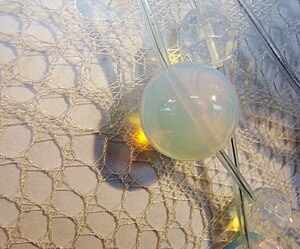Cryolite glass
Cryolite glass (also opal glass ) is glass clouded with the opacifier cryolite (sodium hexafluoroaluminate, formula: Na 3 AlF 6 ) .
Clouded glass is translucent but not transparent glass that appears milky white. The cloudiness is caused by the embedding of the smallest particles with even distribution in the colorless base glass. The particles have a different refraction than the base glass.
During the melt, cryolite is initially converted into fluoride :
- Na 3 [AlF 6 ] gives 3 NaF + AlF 3
The glass is clouded exclusively by sodium fluoride (NaF).
Cryolite was found as a natural raw material (ice stone) in Greenland and has been used since 1868 for the basic glass, the white body of German artificial glass eyes . As a result, the lead glass commonly used in Paris or the leg glass previously used in Lauscha could be replaced and the lifespan of the eye prostheses was considerably extended. Today, chemically obtained cryolite from fluorspar is used.
